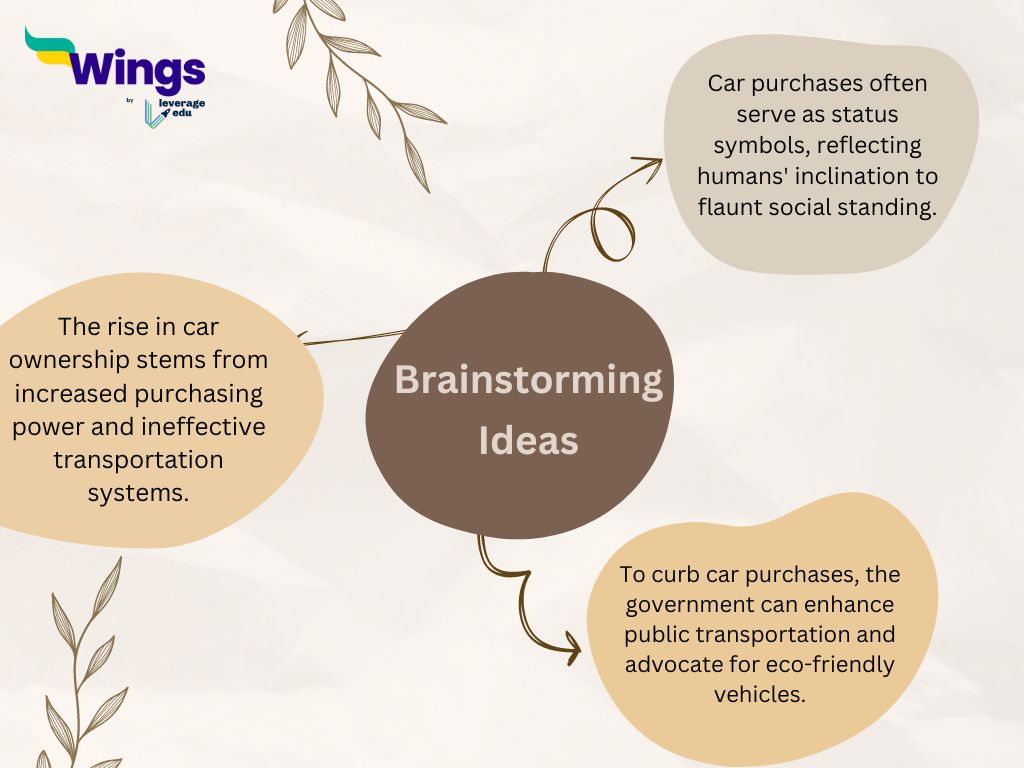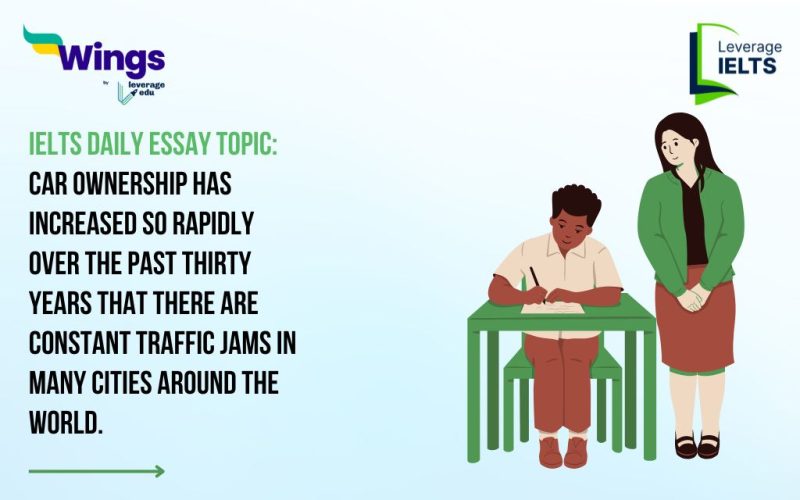Brainstorming Ideas
Here are the following brainstorming ideas that you can look into:
- There are various reasons why there is an increase in ownership of cars including things like an increase in purchasing power and inadequate or inefficient transportation systems.
- People purchase more cars as status symbols. Humans tend to show off in societal circles.
- To discourage people from buying more cars, the government can include various measures such as improving the public transportation system and promoting the use of environmentally friendly vehicles.

Q. Car ownership has increased so rapidly over the past thirty years that there are constant traffic jams in many cities around the world. How true do you think this statement is? What measures can governments take to discourage people from owning cars?
Ans. There has been an increase in the ownership of cars in the past thirty years which has led to persistent traffic jams in numerous cities globally. I believe that this statement is particularly true in developing countries and these can be mitigated by improving public transportation systems and promoting environment-friendly vehicles.
The surge in car ownership is propelled by various factors. One of the primary factors is the increase in purchasing power. As economies expand, individuals’ incomes rise, leading to a greater demand for cars. This is evident in countries like India and China where the burgeoning middle class significantly contributes to the rise in car ownership. Additionally, inadequate or inefficient transportation systems in many cities prompt people to prefer owning their own cars. Most places often grapple with transportation issues due to overcrowded public transport, compelling individuals to prioritize car ownership despite traffic congestion. Moreover, owning a car is often regarded as a status symbol in many societies. In cities across India, despite traffic jams, there is a prevailing aspiration among people to own cars as a means of displaying social status.
To discourage car ownership, governments can implement various measures. Firstly, improving public transportation systems provides an alternative solution for car travel. This can include expanding routes and ensuring affordability. For example, cities such as Delhi and Mumbai are working on expanding their metro networks to provide fast and efficient alternatives to private cars. Secondly, the government can promote the use of environmentally friendly vehicles such as electric cars and bicycles. For example, the Indian government is currently promoting the use of electric vehicles through the FAME II scheme, which provides subsidies for electric vehicle purchases. Additionally, cities like Pune and Bengaluru are promoting cycling through initiatives such as public bicycle-sharing systems.
In conclusion, the rise in car ownership has indeed resulted in increased traffic congestion. However, various strategies, such as improving public transportation systems and promoting the use of environmentally friendly vehicles such as electric cars and bicycles, can be implemented to discourage car ownership and promote sustainable modes of transportation. By adopting these measures, governments can mitigate traffic congestion and contribute to a more sustainable transportation infrastructure.
Analysis
Paraphrased Statement: There has been an increase in the ownership of cars in the past thirty years which has led to persistent traffic jams in numerous cities globally.
Thesis Statement: I believe that this statement is particularly true in developing countries and these can be mitigated by improving public transportation systems and promoting environment-friendly vehicles.
Body Paragraph 1-Topic Sentences: The surge in car ownership is propelled by various factors. One of the primary factors is the increase in purchasing power. As economies expand, individuals’ incomes rise, leading to a greater demand for cars. This is evident in countries like India and China where the burgeoning middle class significantly contributes to the rise in car ownership.
Body Paragraph 1- Supporting Reasons and Explanations: Additionally, inadequate or inefficient transportation systems in many cities prompt people to prefer owning their cars. Most places often grapple with transportation issues due to overcrowded public transport, compelling individuals to prioritize car ownership despite traffic congestion. Moreover, owning a car is often regarded as a status symbol in many societies. In cities across India, despite traffic jams, there is a prevailing aspiration among people to own cars as a means of displaying social status.
Body Paragraph 2- Topic sentence: To discourage car ownership, governments can implement various measures. Firstly, improving public transportation systems provides an alternative solution for car travel. This can include expanding routes and ensuring affordability.
Body paragraph 2- Supporting Reasons and Explanations: For example, cities such as Delhi and Mumbai are working on expanding their metro networks to provide fast and efficient alternatives to private cars. Secondly, the government can promote the use of environmentally friendly vehicles such as electric cars and bicycles. For example, the Indian government is currently promoting the use of electric vehicles through the FAME II scheme, which provides subsidies for electric vehicle purchases. Additionally, cities like Pune and Bengaluru are promoting cycling through initiatives such as public bicycle-sharing systems.
Conclusion: In conclusion, the rise in car ownership has indeed resulted in increased traffic congestion. However, various strategies, such as improving public transportation systems and promoting the use of environmentally friendly vehicles such as electric cars and bicycles, can be implemented to discourage car ownership and promote sustainable modes of transportation. By adopting these measures, governments can mitigate traffic congestion and contribute to a more sustainable transportation infrastructure.
Vocabulary in Use
| Word | Meanings |
| Persistent | Continuously existing for a long or longer than usual time. |
| Rapid urbanization | The quick pace at which people move from rural to urban areas and the societal changes that accompany this shift. |
| Accessible | Something that is easy to approach, reach, enter, speak with, or use. |
| Traffic congestion | A situation in transport marked by slower speeds, longer trip times, and increased vehicular queuing. |
| Multifaceted | Having many different aspects or features. |
| Implication | A potential future effect or result, or something that is hinted at without being explicitly stated. |
| Surge | A sudden and significant increase. |
| Purchase power | The amount of goods or services that one unit of money can buy. |
| Prestige | The respect and admiration given to someone or something, usually due to a reputation for high quality, success, or social influence. |
| Mobility | The capacity or tendency to move from one position or situation to another, typically a better one. |
Linkers and Connectors Used
Following are the linkers and connectors used:
- Firstly
- For example
- Secondly
- For instance
- Additionally
- Lastly’
- In conclusion
Are you preparing for IELTS? Check out this video to improve your writing skills for the IELTS exam given below👇.
Download the Leverage IELTS App today.


Need help preparing for IELTS? Check out the best IELTS preparation courses in the market offered in a live training environment by trusted educators. If you want to help studying abroad, call 1800572130.
 One app for all your study abroad needs
One app for all your study abroad needs















 60,000+ students trusted us with their dreams. Take the first step today!
60,000+ students trusted us with their dreams. Take the first step today!